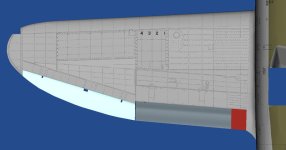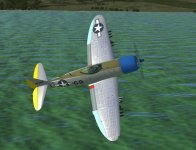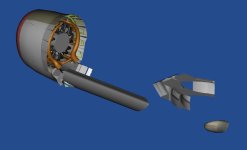-
There seems to be an uptick in Political comments in recent months. Those of us who are long time members of the site know that Political and Religious content has been banned for years. Nothing has changed. Please leave all political and religious comments out of the forums.
If you recently joined the forums you were not presented with this restriction in the terms of service. This was due to a conversion error when we went from vBulletin to Xenforo. We have updated our terms of service to reflect these corrections.
Please note any post refering to a politician will be considered political even if it is intended to be humor. Our experience is these topics have a way of dividing the forums and causing deep resentment among members. It is a poison to the community. We appreciate compliance with the rules.
The Staff of SOH
-
Please see the most recent updates in the "Where did the .com name go?" thread. Posts number 16 and 17.
You should upgrade or use an alternative browser.
P-47 Progress Thread
- Thread starter Frosty
- Start date
Frosty
SOH-CM-2025
Now you have to do the underside, then the fuselage, and then.................
...
Haha, yeah, don't remind me
 !
!I 'd like to get rid of a little stretching at the leading edge of the wing and then I can copy most of these rivets to the right wing. Part of the fuselage is already done but the underside of the wing is as much a pain in the * as the top side is. This is more time consuming than I imagined! But hey, the upside is that once these rivets are done, the real fun begins: bump mapping and weathering! That's much more appealing to me!
Pat Pattle
SOH-CM-2025

Have just been catching up on this one, fantastic detail going into this, extremely impressive!!



Daiwilletti
Charter Member
Can't wait for this bird

Frosty
SOH-CM-2025
Drooool . . . . I've been wondering, what with the crazy large bump map dds files, will I have to sell a kidney and fork out for a decent video card, to properly enjoy such a painstakingly carefully crafted model? ...
Keep your kidneys where they serve best, I would say
 :
:I have an old PC with a graphics card a friend gave to me: Intel i7 2,93GHz 4Gb RAM, originally Win7 Home x64 upgraded to Win10, Radeon HD5700 1024Mb. I get around 50-58 FPS in clear skies with this P-47 model and around 25-30 FPS over ACC airfields. Occasional stutter but nothing serious. I do use GameBooster to close as much background processes as possible before I start CFS3 and TrackIR.
The model texture files are not as big as Renatus' but the model is not finished yet. I am working with 4096x4096 textures, giving roughly 8Mb .dds files.
Daiwilletti
Charter Member
I guess I was thinking aloud about the cumulative effect of all the bump map textures of all the fab new models that are filling CFS3 skies recently. My vid card seems ok apart from a weird model cache overflow reported in the D3D log. It will be great if I can render them in all their glory.
mongoose
SOH-CM-2025
,,,,,
The model texture files are not as big as Renatus' but the model is not finished yet. I am working with 4096x4096 textures, giving roughly 8Mb .dds files.
Joost, I was just thinking about 4096 textures in bed last night
 , as I thought I had read somewhere here that CFS3 would convert those back to 2048?? I seem to think it was something Andy or Dan might have mentioned???
, as I thought I had read somewhere here that CFS3 would convert those back to 2048?? I seem to think it was something Andy or Dan might have mentioned???MajorMagee
SOH-CM-2022
If you don't want to use a mos file then large textures are no problem. I've slowly gotten rid of my mos files over time as I upgraded each legacy aircraft's texture to higher resolution. For me, I'd rather have a high fidelity model most of the time, than seeing bullet hole decals appear on an aircraft that's seconds away from being destroyed anyway.
Frosty
SOH-CM-2025
Gmax doesn't seem to be able to handle my large textures, so I had to downsize the texture setting. But I am having much fun playing with material values - and getting decent results in some places! Cowl flaps, oil cooler doors and intercooler waste gates are depicted in open position. BTW, the texturing isn't finished but for reference I already painted some parts.
Attachments
Pat Pattle
SOH-CM-2025
Frosty
SOH-CM-2025
 . I have to go to CFS3 to see the result of my work.
. I have to go to CFS3 to see the result of my work.I wonder if the material set-up also influences the memory load; Currently I have created two big multi-materials (ca. 22 different material settings) for all external objects (excl. VC), instead of multiple smaller multi-materials. At the time this felt more 'efficient' than a long list of various material combinations but I think this also taxes the system. Not being that PC-savy, it feels like the debate whether loading a multitude of small textures is better for your FPS than a single, large texture. In the end I would expect both methods to give the same amount of Mb loaded, or am I wrong?

Whatever the outcome of such a debate, the multimaterials use the same two 4096 textures but with different material settings, of course. I am using multimaterials to get as 'PBR' as possible Yes, I know CFS3 isn't PBR compatible but I seem to get decent results playing with values derived from that way of designing.
Anyway, you can do much more with the material settings in gmax than I have done with my models so far. We tinker a lot with _r and _s textures etc. but using appropriate settings in gmax also contribute to a convincing model!
Frosty
SOH-CM-2025
... but I wouldn't omit the s.dds, painters can do a lot of nice subtle work with those too!
Now I am a bit confused: I went for a *_r.dds file with this model as I thought the stock bare metal P-47D-25 had one. I just checked and it turns out it has both a *_s.dds and a *_r.dds file. Yet the SDK states that you can't have both simultaneously! Both stock files do look quite similar. Now what?

Frosty
SOH-CM-2025
Is there a preference for either the *_r.dds or the *_s.dds and if so, could someone tell me why?
MajorMagee
SOH-CM-2022
AnKor's shaders take advantage of the r file's specular information to regulate the strength of the localized glossiness (great for highlighting chipped paint spots), but typically do their own shading through their self-shadowing routines.
The issue with using any sort of texture map to define the lighting qualities of a 3D object that moves through space like an airplane (versus trucks, buildings, trees, etc.) is that they are static, when the lighting is not. Paint in a dark to bright gradient along the top of a curved surface to emphasize the sun falling on it from above using an s file, and it will look wrong when the aircraft banks. Give the surface material a uniform brightness with AnKors shaders and they will automatically adjust the brightness gradient on the surface based on the relative direction of the sun.
AnKor's shaders also allow us to use normal maps to assist with the dynamic lighting in game. The intention here is to create the illusion of bumps using height difference information that changes the local direction vector of the light bouncing off an otherwise flat polygon surface. Again this is predetermined in a static texture map, so it may give erroneous results as the aircraft moves and turns in space, but if we're dealing with small features like panel lines and rivets the illusion works well enough most of the time.

 . Gmax screenie:
. Gmax screenie:


